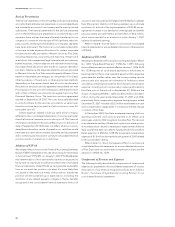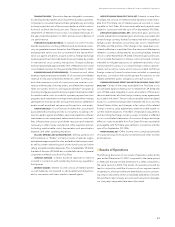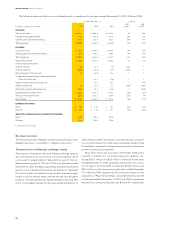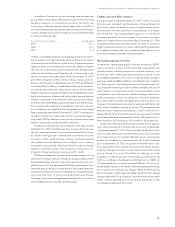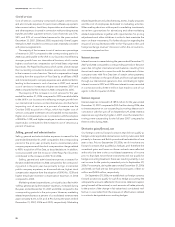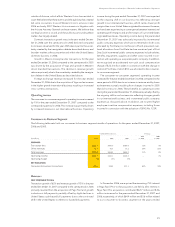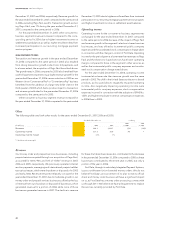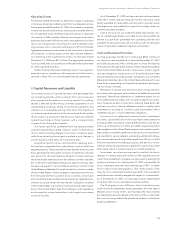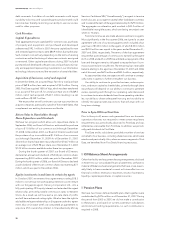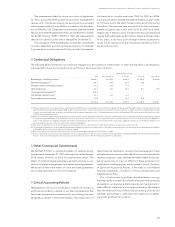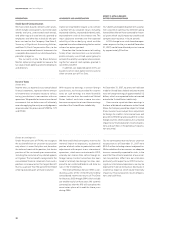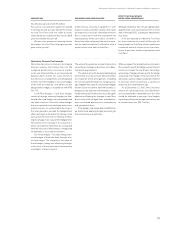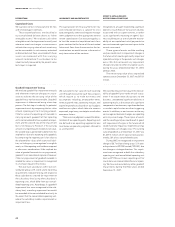Western Union 2007 Annual Report Download - page 32
Download and view the complete annual report
Please find page 32 of the 2007 Western Union annual report below. You can navigate through the pages in the report by either clicking on the pages listed below, or by using the keyword search tool below to find specific information within the annual report.30
WESTERN UNION 2007 Annual Report
We have and intend to continue to implement strategic pricing
reductions, including actions to reduce foreign exchange spreads,
where appropriate, taking into account growth opportunities
and competitive factors. Pricing decreases and foreign exchange
actions generally reduce margins, but are done in anticipation
that they will result in increased transaction volumes and increased
revenues over time. Such overall pricing decreases and foreign
exchange actions have averaged approximately 3% of our annual
consolidated revenue over the last three years, a trend that is
expected to continue.
Contributing to the increase in total consumer-to-consumer
money transfer revenue and transaction growth in all periods
presented was the growth in transactions at existing agent loca-
tions, the increased number of agent locations and marketing
campaigns promoting Western Union services. The majority of
transaction growth is derived from more mature agent locations;
new agent locations typically contribute only marginally to
revenue growth in the fi rst few years of their operation. Increased
productivity, measured by transactions per location, is often
experienced as locations mature. We believe that new agent
locations will help drive growth by increasing the number of
locations available to send and receive money. We generally
refer to locations with more than 50% of transactions being initi-
ated (versus paid) as “send locations” and to the balance of
locations as “receive locations.” Send locations are the engine
that drives consumer-to-consumer revenue. They contribute more
transactions per location than receive locations. However, a wide
network of receive locations is necessary to build each corridor
and to help ensure global distribution. The number of send and
receive transactions at an agent location can vary signifi cantly
due to such factors as customer demographics around the loca-
tion, immigration patterns, the location’s class of trade, hours of
operation, length of time the location has been offering our
services, regulatory limitations and competition. Each of the more
than 335,000 agent locations in our agent network is capable of
providing one or more of our services; however, not every location
completes a transaction in a given period. For example, as of
December 31, 2007, more than 85% of agent locations in the
United States, Canada and western Europe (representing at least
one of our three money transfer brands) experienced money
transfer activity in the last 12 months. In the developing regions
of Asia and other areas where there are predominantly receive
locations, more than 65% of locations experienced money transfer
activity in the last 12 months. We periodically review locations to
determine whether they remain enabled to perform money
transfer transactions.
2006 COMPARED TO 2005
Consumer-to-consumer money transfer revenue growth for the
year ended December 31, 2006 over the same period in 2005
was driven by international revenue growth and the acquisition
of Vigo, which was completed in October 2005. Vigo contributed
$140.5 million and $24.2 million in total revenue for the years
ended December 31, 2006 and 2005, respectively. This revenue
growth was offset by declines in our domestic businesses and a
slow down in revenue growth in our Mexico business, both of
which began in the second quarter of 2006.
International revenue growth in the year ended December
31, 2006 compared to the same period in 2005 resulted from
growth in money transfer transactions and the acquisition of Vigo.
International money transfer transaction growth in the year
ended December 31, 2006 compared to the prior year period
was driven most signifi cantly by growth in the United States and
European outbound businesses. The international transaction
growth rate excluding Vigo for the year ended December 31,
2006 of 24% and was directionally consistent with the 26%
growth rate for the comparable period in 2005. Although inter-
national intra-country transaction growth remained strong in
2006, the overall international transaction growth rate during
2006 was impacted by high transaction growth rates experienced
in the intra-country business in the second half of 2005, particu-
larly in the Philippines.
The key inbound markets of India and China continued to
grow, with transactions in India more than doubling and China
transaction growth rates exceeding 35% for the year ended
December 31, 2006. For the year ended December 31, 2006,
India and China combined represented approximately 4% of
Western Union consolidated revenues.
Fluctuations in the exchange rate between the euro and the
United States dollar have resulted in a benefi t or (reduction) to
consumer-to-consumer transaction fee and foreign exchange
revenue of $11.5 million and $(1.4) million in 2006 and 2005,
respectively, over the previous corresponding year. This benefi t
or reduction to consumer-to-consumer revenue would not have
occurred had there been a constant exchange rate, and was net
of the impact of our foreign currency hedges.
The relationship between international transaction growth
and revenue growth was relatively consistent during the year
ended December 31, 2006 compared to the corresponding
period in 2005. Transactions related to Vigo, which have lower
revenue per transaction compared to the Western Union branded
business, benefi ted transactions more than revenue. Offsetting
this impact was the benefi t to revenue from the euro described
above, which did not have a corresponding benefi t to transac-
tions compared to 2005.
Revenue for the year ended December 31, 2006 for our United
States to Mexico, United States outbound and domestic busi-
nesses was adversely impacted by various factors in the United
States, including the immigration debate, which raised concerns
with certain consumers in the United States and decreased the
frequency of money transfers from the United States to Mexico
and other countries. These concerns, together with general
market softness, in part due to the slow down in the construction
industry, led some competitors to lower fees and reduce foreign
exchange spreads in certain markets.
In 2006, Western Union was also impacted by the actions of
the Offi ce of Attorney General in the State of Arizona which also
may have added to the uncertainty with some of our consumers.
The Arizona Attorney General seized money transfers initiated
in Arizona during certain periods in 2006, and, in September
2006, sought to seize money transfers originated in other states
and intended for payment in certain areas of Mexico. Western
Union obtained an injunction preventing such seizures, and the
Arizona Attorney General has appealed that injunction.
Furthermore, the Arizona Attorney General sought personal
information about a large number of Western Union customers




